2.7 Using the Inspector Tools
iManager contains a set of tools that allows you to inspect objects associated with Identity Manager and Identity Manager objects.
2.7.1 Inspecting Objects
The Identity Manager Object Inspector is a tool that an administrator can use to view detailed information about how an object participates in Identity Manager relationships. These relationships include the connected systems that are associated with the selected object, how data flows between the Identity Vault and the connected systems, the attribute values that are currently stored in the Identity Vault and on the connected systems, the connected system driver configurations, etc.
-
Click the task under the role to bring up the page.
This page allows you to select an object on which to run the Identity Manager Inspector.
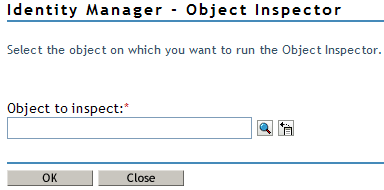
-
Specify the fully distinguished name of the object that you want to inspect, or click the icon
 to select the desired object.
to select the desired object.
iManager keeps a record of the objects you have previously selected, so you can also use the icon
 to select from a list of previously selected objects.
to select from a list of previously selected objects.
-
Click after you select the object.
The Object Inspector page lists information about the connected system in a table.
Figure 2-1 Object Inspector
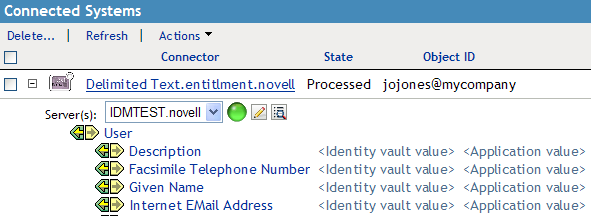
-
Delete: To delete an association with a connected system, select the check box to the left of the association and click . To delete all associations, select the check box beneath the Delete column, then click .
-
Refresh: Select to re-read the connected system associations and refresh the table.
-
Actions: Select a connected system by clicking the check box to the left of the association reference (you do not need to select any boxes for the Add New Association action item). Click to expand its menu, which includes:
-
Run Overview on Driver: Launches the overview page for the connected system's driver in a pop-up window.
-
Run Overview on Driver Set: Launches the overview page for the connected system's driver set in a pop-up window.
-
Configure Driver: Launches the properties page for the connected system's driver in a pop-up window.
-
Configure Driver Set: Launches the properties page for the connected system's driver set in a pop-up window.
-
Add New Association: Prompts you for the parameters necessary to add new attribute values to the object's DirXML-Association attribute.
-
Edit Association: Prompts you to edit the parameters of the connected system's DirXML-Association attribute values.
-
-
Connector: Prompts you to edit the parameters of the connected system's DirXML-Association attribute values.
The Servers entry shows the servers that are associated with driver's driver set. Clicking the icon to the right of the server brings up the server's properties page in a pop-up window. Clicking the icon queries the attribute values for all classes in the driver filter. The larger the filter, the longer the query takes. If the Inspector cannot communicate with the connected system, you see a message stating that the attribute cannot be queried from the application.
The driver filter's associated classes (such as Group) and their attributes (such as Description and Member) are listed under the Server entry. Click the class to see all of the values for the defined attributes in that class. You can also click an attribute to see its values, or you can click the entries to the right of the attributes to see just the Identity Vault value or the application value. If no value has been defined, the entry displays No Values. If the Inspector cannot communicate with the connected system, you see a message stating that the attribute cannot be queried from the application.
-
States: The connected system's driver states are Enabled, Disabled, Processed, Pending, Manual, and Migrate.
-
Object ID: The identification value of the associated object to the connected system. If the connected system driver has no identification, this column displays .
2.7.2 Inspecting Drivers
The Identity Manager Driver Inspector is a tool that an administrator can use to view detailed information about the objects associated with the selected driver. To access the Driver Inspector:
-
In iManager, select .
-
Browse to and select the driver to inspect, then click .
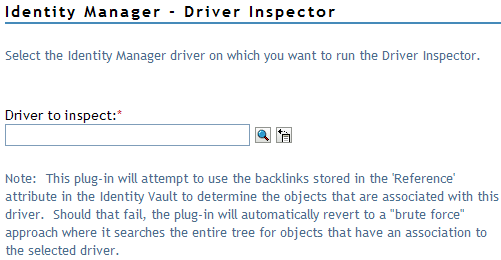
The Identity Manager Driver Inspector table displays information about the objects associated with the selected driver.
Figure 2-2 Identity Manager Driver Inspector Table
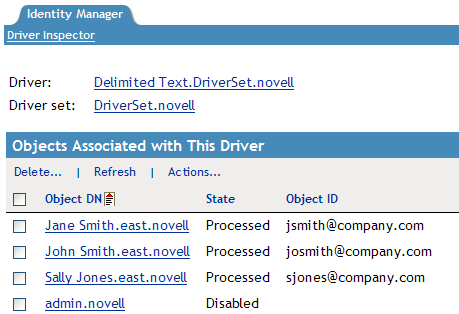
-
Driver: A link to run the Driver Overview on the driver that is being inspected.
-
Driver Set: A is a link to run the Driver Set Overview of the driver set that holds the driver.
-
Delete: Deletes the associations of the selected objects.
-
Refresh: Select this option to re-read all of the objects associated with the driver and refresh the displayed information.
-
Actions: Perform actions on the objects associated with the driver. Click to expand the menu, which includes:
-
Show All Associations: Displays all objects associated with the driver.
-
Filter for Disabled Associations: Displays all objects associated with the driver that have a Disabled state.
-
Filter for Manual Associations: Displays all objects associated with the driver that have a Manual state.
-
Filter for Migrate Associations: Displays all objects associated with the driver that have a Migrate state.
-
Filter for Pending Associations: Displays all objects associated with the driver that have a Pending state.
-
Filter for Processed Associations: Displays all objects associated with the driver that have a Processed state.
-
Filter for Undefined Associations: Displays all objects associated with the driver that have an Undefined state.
-
Association Summary: Displays the state of all objects associated with the driver.
-
-
Object DN: Displays the DN of the associated objects.
-
State: Displays the association state of the object.
-
Object ID: Displays the value of the association.
2.7.3 Inspecting the Driver’s Cache File
The Identity Manager Driver Cache Inspector displays information about the cache file that stores events while the driver is stopped.
-
In iManager, select .
-
Browse to and select the driver on which to run the Identity Manager Driver Cache Inspector.
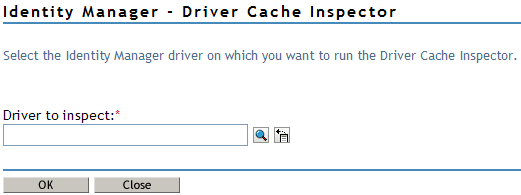
The Identity Manager Drive Cache Inspector page uses a table format to display information about the cache file that stores events while the driver is stopped.
Figure 2-3 Identity Manager Driver Cache Inspector
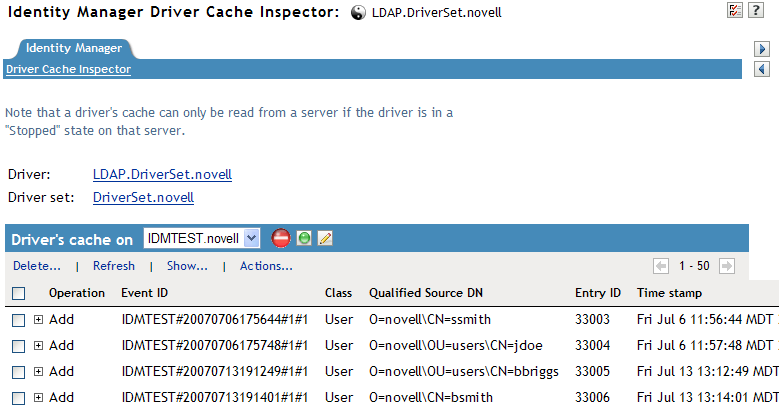
-
Driver: A link to run the Driver Overview on the driver that is associated with this cache file.
-
Driver Set: A link to run the Driver Set Overview on the driver set that holds the driver.
-
Driver’s cache on: Lists the server object that contains this instance of the cache file.
-
Start/Stop Driver icons: Displays the current state of the driver and allows you to start or stop the driver.
-
Edit icon: Allows you to edit the properties of the currently selected Server object.
-
Delete: Deletes the selected items in the cache file.
-
Refresh: Select this option to re-read the cache file and refresh the displayed information.
-
Show: Limits the number of items to be displayed. The options are:
-
25 per page
-
50 per page
-
100 per page
-
Other: Allows you to specify a desired number.
-
-
Actions: Allows you to perform actions on the entries in the cache file. Click Actions to expand the menu, which includes:
-
Expand All: Expands all of the entries displayed in the cache file.
-
Collapse All: Collapses all of the entries displayed in the cache file.
-
Go To: Allows you to access a specified entry in the cache file. Specify the entry number, then click .
-
Cache Summary: Summarizes all of the events stored in the cache file.
-